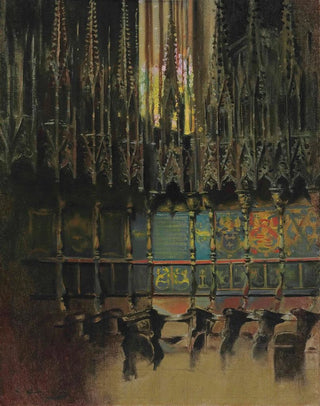Art print | Interior of the cathedral - Ramon Casas


View from behind

Frame (optional)
Interior Art print of the cathedral - Ramon Casas – Captivating introduction
In the vibrant world of art, some works stand out for their ability to capture the essence of a place, an atmosphere, a period. "Interior of the cathedral - Ramon Casas" falls into this category, offering the viewer an immersion into a sacred space where light and shadow dance in harmony. The piece transports us to the heart of a cathedral, revealing not only the majestic architecture but also the spiritual intimacy that these places of worship can evoke. Ramon Casas's mastery in the use of colors and shapes invites deep contemplation, encouraging us to explore the hidden stories behind each stone.
Style and uniqueness of the work
Ramon Casas's work is characterized by a unique style, blending realism with a certain visual poetry. In "Interior of the cathedral," he succeeds in capturing not only the architectural structure but also the mystical atmosphere that prevails in these places of devotion. The play of light, filtered through stained glass windows, creates vibrant reflections on the walls and floor, giving the entire scene an almost supernatural atmosphere. The composition is carefully orchestrated, with each element precisely placed to guide the viewer's gaze. The color palette, both rich and subtle, evokes an emotional depth that transcends mere visual representation. This piece does not simply depict a space; it invites a sensory experience where time seems suspended.
The artist and his influence
Ramon Casas, an emblematic figure of the Catalan art scene at the end of the 19th century, knew how to mark his era with his innovative approach and artistic sensitivity. Influenced by European currents, notably modernism, he managed to incorporate elements of his cultural heritage while exploring new techniques. Casas was not just a painter but also an observer of his time, capturing social and cultural transformations in his environment. His work has inspired many contemporary artists and helped redefine the standards of Spanish painting. Through "Interior of the cathedral," he demonstrates his attachment to

Matte finish

View from behind

Frame (optional)
Interior Art print of the cathedral - Ramon Casas – Captivating introduction
In the vibrant world of art, some works stand out for their ability to capture the essence of a place, an atmosphere, a period. "Interior of the cathedral - Ramon Casas" falls into this category, offering the viewer an immersion into a sacred space where light and shadow dance in harmony. The piece transports us to the heart of a cathedral, revealing not only the majestic architecture but also the spiritual intimacy that these places of worship can evoke. Ramon Casas's mastery in the use of colors and shapes invites deep contemplation, encouraging us to explore the hidden stories behind each stone.
Style and uniqueness of the work
Ramon Casas's work is characterized by a unique style, blending realism with a certain visual poetry. In "Interior of the cathedral," he succeeds in capturing not only the architectural structure but also the mystical atmosphere that prevails in these places of devotion. The play of light, filtered through stained glass windows, creates vibrant reflections on the walls and floor, giving the entire scene an almost supernatural atmosphere. The composition is carefully orchestrated, with each element precisely placed to guide the viewer's gaze. The color palette, both rich and subtle, evokes an emotional depth that transcends mere visual representation. This piece does not simply depict a space; it invites a sensory experience where time seems suspended.
The artist and his influence
Ramon Casas, an emblematic figure of the Catalan art scene at the end of the 19th century, knew how to mark his era with his innovative approach and artistic sensitivity. Influenced by European currents, notably modernism, he managed to incorporate elements of his cultural heritage while exploring new techniques. Casas was not just a painter but also an observer of his time, capturing social and cultural transformations in his environment. His work has inspired many contemporary artists and helped redefine the standards of Spanish painting. Through "Interior of the cathedral," he demonstrates his attachment to






